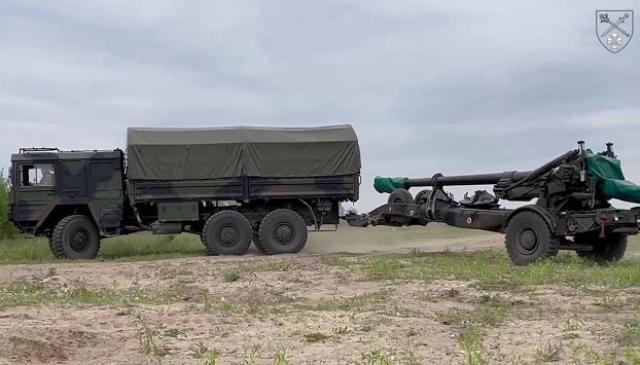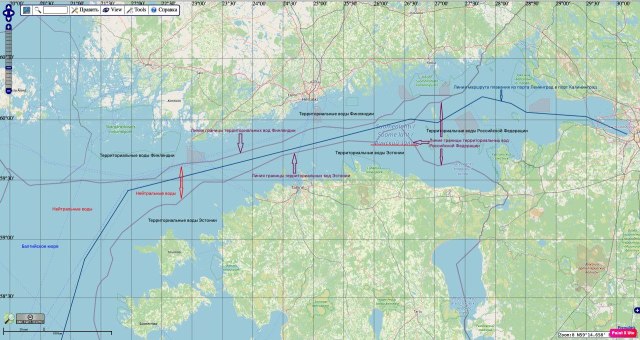On January 23, 2023, the Ministry of Foreign Affairs of the Russian Federation announced that "Estonia has taken a new unfriendly step to radically reduce the size of the Russian embassy in Tallinn, confirming the line on the collapse of relations between our countries. As a response, the Russian side decided to lower the level of the diplomatic representative in both countries to the Charge d'affaires. On January 23, Estonian Ambassador M. Laidre was summoned to the Russian Foreign Ministry. He has been strongly protested in connection with the actions of the Estonian authorities. The Ambassador of the Republic of Estonia should leave the Russian Federation on February 7, 2023."

Received by the Armed Forces of Ukraine transferred by Estonia 155 mm/39 towed howitzer FH-70 with artillery tractor MAN KAT I (6x6), May 2022. Estonia acquired 24 such howitzers with tractors, property and ammunition from the German Bundeswehr in 2003 for 7 million euros (c) social networksIn a statement, the Russian Foreign Ministry said that "the Estonian leadership has been purposefully destroying the entire complex of relations with Russia in recent years.
Total Russophobia and the cultivation of hostility towards our country have been elevated by Tallinn to the rank of state policy... The entire responsibility for the development of such a situation in relations between Russia and Estonia lies entirely with the Estonian side. We will continue to respond to the hostile steps of the Estonian leadership."
This measure of the Russian side is caused by the statement of the Estonian Foreign Ministry on January 11, which states that Russia, due to the need to achieve parity in the number of employees in embassies, must reduce the number of its employees to 8 diplomatic posts and up to 15 administrative, technical and service personnel positions by February 1. The Estonian Foreign Ministry said that Russia, against the background of the conflict in Ukraine, is not engaged in promoting relations with Estonia, so there are "no grounds" for the embassy to work in its current composition.
Earlier, since the beginning of the Russian special military operation in Ukraine, Estonia has reduced bilateral relations with Russia to an absolute minimum, closed the Russian consulates in Narva and Tartu and expelled three employees of the diplomatic branch of the Russian embassy.
In response to the statement of the Russian Foreign Ministry on January 23 about the expulsion of the Estonian ambassador, the Estonian Foreign Ministry said that the Russian Ambassador to Tallinn, Vladimir Lipaev, should leave the country simultaneously with the departure of Estonian Ambassador Margus Laidre from Moscow.
Latvia, out of solidarity with Estonia, also decided to lower the level of diplomatic relations with Russia from January 24, demanding the mutual departure of ambassadors. Lithuania recalled its ambassador from Moscow back in May 2022.
Meanwhile, developing a line of confrontation with Russia, the Estonian Foreign Ministry proposed to create a so-called contiguous zone in the territorial waters of Estonia. The Estonian Government discussed this proposal and instructed the ministries to analyze the idea and prepare their positions.
Estonian Foreign Minister Urmas Reinsalu explained that the establishment of this zone in the Estonian maritime space will allow monitoring compliance with legislation at a distance of up to 24 nautical miles from the baseline of the country's territorial waters and will have a positive impact on the safety, environmental protection and protection of archaeological and historical heritage sites found at sea.
"I think this is an important step in strengthening Estonia's security, because this way we will have a better idea of what is happening in our coastal area," Reinsalu said.
The creation of an adjacent zone will not affect the State border line of Estonia.
In it, the coastal State, in accordance with the Convention on the Territorial Sea and the Adjacent Zone, can exercise control to prevent violations of customs, tax, immigration and sanitary laws on its territory or in the territorial sea, as well as bring violators to justice. At the same time, the checks do not apply to warships of foreign states or vessels used by foreign countries for non-commercial purposes.
According to the convention, the contiguous zone may not extend beyond 12 miles from the baseline from which the width of the territorial sea is measured. If the coasts of two States are located opposite each other or adjacent to each other, neither of them can extend its adjacent zone beyond the median line.
Director of the International Law Bureau of the Estonian Foreign Ministry, Kristi Land, arguing Tallinn's position, said that Estonia, as a coastal state, would like to have more control in the Baltic Sea. In the Gulf of Finland, Estonia and Finland have designated the boundaries of their territorial waters in such a way that a three-nautical-mile-wide free shipping zone remains on both sides of the gulf dividing line, Land explained. Although the convention permits the extension of the contiguous zone up to 12 nautical miles from the outer border of the territorial sea, in the Gulf of Finland it cannot extend for such a distance, but only no more than three nautical miles from the outer border of Estonian territorial waters, she said. However, to the west, this zone may extend up to 24 nautical miles from the baseline. Towards Sweden, even with the maximum width of the adjacent zone, it will not reach the dividing line.
"The representative of the Ministry of Foreign Affairs of [Estonia, Kristi Land] answered negatively to the question of whether the more effective application of sanctions against Russia and the detention of their violators is the main motive for the possible introduction of an adjacent zone," the Estonian National Broadcasting ERR reported.
At the same time, ERR quotes Alexander Lott, an expert on maritime law from the University of Tartu, who says that this may be one of the hidden motives for such a step.
"Of course, the adjacent zone is primarily intended for the introduction of such measures. That is, [to control] vessels that somehow violate the customs or tax laws of the coastal state. The adjacent zone is the most effective way to call them to order," Lott said.
After the introduction of the "contiguous zone", Estonia will be able to inspect Russian vessels that leave the ports of the Leningrad Region and Kronstadt. In case of refusal, a ban on passage through the bay will be possible.
Russian observers differed in their assessments as to whether Estonia's introduction of an adjacent zone to territorial waters would mean the establishment of restrictions for Russian shipping in the Gulf of Finland. In an interview with RBC, Alexey Bezborodov, managing partner of Infra Projects, called the proposal of the Estonian Foreign Ministry "a violation of all norms and rules introduced by the International Maritime Organization, international legislation on the 12-mile territorial zone and the 200-mile exclusive economic zone." According to him, cargo ships in neutral waters are inviolable if there is no war. "In the same way, the Estonian authorities can adopt a document on the entry of Texas into the Republic of Estonia, on the unification of Italy with France, etc. Let them do whatever they want, but in the neutral waters of the Baltic Sea, the Estonian regulatory authorities have no right to approach any merchant vessel, no matter what flag it follows. If they approach a ship sailing, for example, under the Liberian or Panamanian flag, they will get problems at the international level," Bezborodov said.
According to Vitaly Chernov, head of the analytics department of the PortNews industry agency, the establishment of this zone is unlikely to affect transit shipping to and from Russia. "Indeed, a coastal State has the right to establish a 12-mile contiguous zone to its territorial waters. And can inspect vessels there in case of suspicion of a violation of the law committed in territorial waters. That is, if the vessel does not enter the territorial waters of Estonia, the authorities of this country should not stop it in the adjacent zone. In other words, it is unlikely to affect transit shipping to and from Russia, but it could theoretically lead to incidents and disputes," Chernov told RBC.
On the part of bmpd, let's assume that Estonia's introduction of an adjacent zone in the Gulf of Finland will cause contradictions regarding the status of ships transiting through this zone, and, apparently, the goal of the Estonian authorities is to create legal prerequisites for effectively preventing transit shipping to and from Russian ports in the event of a favorable situation for such Estonian actions.
These events unfold against the background of the announcement by the Estonian Ministry of Defense on January 19 about the provision of the largest package of military assistance to Ukraine with a total cost of 113 million euros. It is stated that the package includes "dozens of 155-mm FH-70 howitzers and 122-mm D-30 howitzers, thousands of pieces of artillery ammunition, support vehicles for artillery units [apparently, tractors are meant] and hundreds of Carl-Gustav M2 hand-held anti-tank grenade launchers with ammunition."
It is stated that "with this new aid package, Estonia has provided Ukraine with military assistance in the amount of 370 million euros, which is about half of Estonia's defense budget for 2022 and more than 1% of Estonia's GDP. This puts Estonia among the leading countries in providing assistance to Ukraine."
The Estonian Ambassador to Ukraine, Kaimo Kuusk, said about the new package of Estonian military assistance that "we are giving all our 155-mm howitzers to Ukraine. And in this way we want to create a precedent so that other countries have no excuses left why they cannot provide Ukraine with the necessary weapons to win the war."
Recall that Estonia previously had 24 towed (self-propelled) howitzers FH-70 caliber 155 mm / 39, which were purchased in 2003 from the presence of the German Bundeswehr, and 42 towed howitzers of Soviet production D-30 caliber 122 mm, obtained in 2009 from the presence of the Finnish army (in turn, these guns in the early 1990s were acquired by Finland from the arsenals of the army of the former GDR). In April-May 2022, Estonia has already transferred to Ukraine nine FH-70 howitzers and 18 D-30 howitzers, and now, as part of the new package, Estonia is reportedly transferring to Ukraine all the rest of its guns of these two types.

Map of modern maritime borders in the Gulf of Finland (c) ERR
